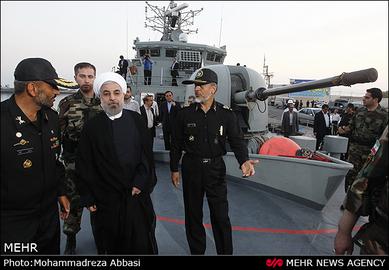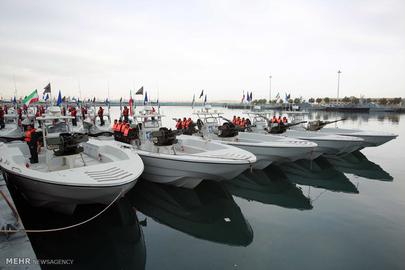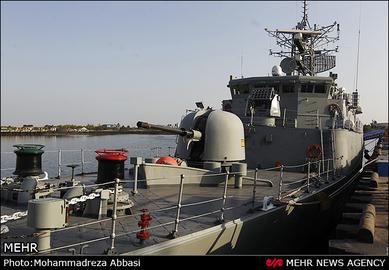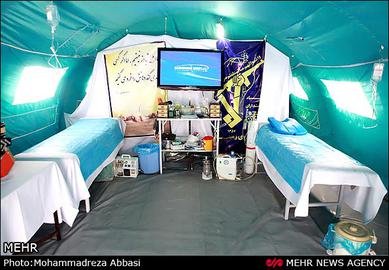The Revolutionary Guards: An Introduction
The Islamic Revolutionary Guard Corps (IRGC) is the Islamic Republic of Iran’s most important institution. The military-security institution commands huge influence in every aspect of Iranian public life, from culture and the environment to the economy, politics and judicial process. Whatever the field or area, the IRGC is not required to report to anybody and is answerable to no one.
The IRGC was created early after the 1979 Islamic Revolution by the order of the founder of the Islamic Republic, Ayatollah Ruhollah Khomeini. Its declared mission was to safeguard the revolution and its accomplishments. As the years have gone by, it has expanded its sphere of activities. The entities under its control have multiplied to such a degree that it now operates effectively as a parallel government. It interferes in all current affairs of the country and it aims to have control over every aspect of the way Iran is run.
In a series of reports, IranWire presents a detailed portrait of this powerful and mysterious institution and, for the first time, identifies and explains all bodies, institutions and other entities operating under the umbrella of the Revolutionary Guards, at the same time outlining its activities through an infographic and an interactive diagram.
The infographic is a visual representation of the Guards’ organizational structure and presents all institutions under the control of IRGC in one map. It resembles a family tree, a portrait of the IRGC with all its children, grandchildren and great-grandchildren — a dramatic picture of power in Iran today.
In the interactive diagram, the viewer is able to use the mouse to see how various entities under the control of the Guards emerged, and how they are connected — exactly like a family tree.
IranWire has aimed for this series and the overall project to be informative and a solid research tool. But it is not perfect, and there will always be room for updates, enhancements and further information. We welcome your views, ideas and knowledge, so please do get in touch via email, Twitter or Facebook.
***
The IRGC Navy (Nirooy-e Daryaei-e Sepah)
The establishment of the IRGC Navy (NEDSA) dates back to 1981. During the early years of the Iran-Iraq War (1980–1988) its newly created unit was based in the Khowr-e Musa islands in the Persian Gulf, close to Iraq.
From 1982, the naval unit began expanding and gradually carried out all naval operations. The unit first began its operations from the IRGC Nuh and Masoudieh naval bases. On September 17, 1985, Ayatollah Ruhollah Khomeini wrote a letter to the chief commander of the IRGC, Mohsen Rezaei, and gave him the task of establishing the IRGC’s Ground, Navy, and Air Forces. During the war with Iraq, the IRGC Navy played an important role and led some major operations, such as Valfajr VIII, which led to the capture of the strategic Al-Faw Peninsula, close to the Iraqi city of Basra.
In the period immediately after the war, the IRGC’s main priority was to maintain its position in the Persian Gulf. From 1990 to 1997, the chief commander of the Islamic Republic’s Navy, Ali Shamkhani, was also the head of the IRGC Navy. But in 1997, an independent chief commander was appointed as the head of the IRGC Navy, and the force entered a new era and expanded its naval presence in the region.
The first stage of this expansion was the establishment of a new headquarters called Khatam-al-Anbiya II. The expansion of the IRGC Navy intensified when, in 1999, it was tasked with the security of the Persian Gulf and the Strait of Hormuz. This area consists of a 745-mile sea border with Iraq, Kuwait, Saudi Arabia, Qatar, Bahrain, Oman, and the United Arab Emirates. The IRGC Navy divided this border into five operational areas, which are all now under the control of the Khatam-al-Anbiya II Headquarters. The Khatam-al-Anbiya I Headquarters, which belongs to the Islamic Republic’s Navy, is also in this region but is operationally under the supervision of the Khatam-al-Anbiya II Headquarters. The IRGC Navy has bases in Bushehr, Bandar Lengeh, Asaluyeh, Mahshahr, Abu-Musa Island, and Bandar Abbas.
The IRGC also has an international base around the Strait of Hormuz, which supports the airborne and naval operations of the IRGC in the area. The IRGC Navy also has bases in Jask and Chabahar on the shore of the Gulf of Oman, but the Islamic Republic’s Navy - and not the IRGC - is responsible for the security of this area. In the north of the country, the most important maritime base is Samen-al-Hojaj, located at Babolsar.
The IRGC Navy has five divisions including navy fleet, missiles, commandos, naval aviation, and drones. Its five regions in the Persian Gulf are as follows:
1. Saheb-al Zaman (the 12th, Hidden Imam of Shias) is based in Bandar Abbas. Because of the close proximity to the Strait of Hormuz, this is the IRGC Navy’s most important base.
2. Nuh Nabi (Noah the Prophet) is based in Bushehr and is tasked with the safety and security of the Khark Island.
3. Imam Hussein (the 3rd Imam of Shias) is based in the port of Mahshahr.
4. Sar-Allah (the blood of Allah) is based in the Asaluyeh Port.
5. Imam Mohammad Bagher (the 5th Imam of Shias) is based in Bandar Lengeh and is tasked with the security and safety of four islands: Abu-Musa, Sirri, and Greater and Lesser Tunbs. It also covers the area from the end of Qeshm Island to the west of Kish Island.
The IRGC Navy’s commanding station is based in Bandar Abbas. In addition to securing the sea borders, this force has also participated in other operations such as safeguarding commercial ships and cargos and fighting against pirates.
The IRGC Navy has capacity for asymmetric warfare, such as using naval mines, attacks with speedboats carrying missiles, and suicide missions. Some of these measures have been showcased in IRGC Navy maneuvers.
The Commander of the IRGC Navy
The Supreme Leader, as the commander in chief of the Armed Forces, upon the recommendation of the chief commander of the IRGC, appoints the chief commander of the IRGC Navy. Since its origin in 1985, the IRGC Navy chief commanders have been: Hussein Alaei (September 1985-December 1990), Ali Shamkhani (December 1990-August 1997), Ali-Akbar Ahmadian (August 1997-July 2000), Morteza Saffari (July 2000-April 2010), Ali Fadavi (April 2010-August 2018) and Ali-Reza Tangsiri (August 2018-present).
The Supreme Leader’s Representative
The Supreme Leader’s representative in the IRGC Navy is appointed by the Supreme Leader’s representative in the IRGC. The representative has its own offices in all five regions. The Supreme Leader’s representative in the IRGC Navy is responsible for appointing the head of the following divisions of the IRGC Navy: political, public relations, and publicity.
The Divisions
The deputy commander of the IRGC Navy is appointed by the commander of the IRGC. The Navy has the following divisions: intelligence, investigation, development, cultural, safety, training, operations, coordination, human resources, and medical.
The Khatam-al-Anbiya II Headquarters
The IRGC Navy’s most important task is the safety and security of the Persian Gulf and Strait of Hormuz. The IRGC Navy executes this task through its five bases in the south, but the Khatam-al-Anbiya II Headquarters is the most active base.
In the same region, the Khatam-al-Anbiya I Headquarters (which belongs to the Islamic Republic’s Navy) is also active, but the IRGC base is considered to be more significant. Both headquarters are under the control of the Khatam-al-Anbiya Central Headquarters, which is located in Tehran.
The central headquarters was the commanding base during the last years of the Iran-Iraq war and organized and executed many military operations. Currently, it mainly acts as an operational coordinator for military bases in different parts of the country.
The Asef Missile Corps
The Asef Missile Corps is located in Minab and is the IRGC Navy’s most important missile corps. There are four brigades that are subsidiaries of the corps.
The Aba-Abdullah Commandos Special Forces (Niroohay-e Vijeyeh Takavari-e Aba-Abdullah)
The Aba-Abdullah Commandos Special Forces is one of the most important IRGC Navy units. The name of the unit means “the father of all those who praise Allah” and refers to Imam Hussein, the 3rd Imam of Shias. The unit was established in 2007 on Farur Island in the Persian Gulf, 25 km off Iran’s mainland. The unit has 500–600 commandos and has participated in a number of operations against pirates.
In June 2016, IRGC Navy Commander Ali Fadavi, talked to the media about training the naval forces of the “axis of resistance,” i.e. Iran’s allies in the Middle East who fight against Israel. In recent years, the IRGC has trained and recruited many members of this axis, who have eventually fought alongside IRGC forces in different countries including Iraq, Yemen and Syria.
The Imam Sajjad Commandos and Marine Corps (Tip-e Takavaran va Tofangdaran-e Daryaei-e Imam Sajad)
The Imam Sajjad Commandos and Marine Corps is located on Abu-Musa Island and is in charge of the IRGC’s defense operations in the Persian Gulf Islands. The corps is important because of the presence of 180 islands in the Persian Gulf, with Qeshm being the largest island there. The name of the corps refers to the 4th Imam of Shias. The most important and strategic of the islands in Persian Gulf are Sirri, the Greater and Lesser Tunbs, and Abu-Musa. Apart from the Imam Sajjad Corps, another corps, Ansar-al-Hojat, is also active in this area. In the words of the IRGC’s naval official, Sadeq Amuie, the islands are an important defense against potential threats, attacks and infiltration by the enemy. The corps’ defense of the islands has the aim of preventing enemy forces from organizing themselves before they are able to reach them.
The Underground Naval Base
The existence of an underground naval base was officially announced in February 2016. The IRGC Navy has disclosed that it keeps a heavy arsenal, speedboats, and the Iranian-made super cavitation Hoot torpedo here. The IRGC has not released much information about the details or whereabouts of this base.
Imam Khamenei Naval University (Daneshgah-e Daryaei-e Imam Khamenei)
The university is located in the city of Zibakenar in Gilan province. This is an unusual name for an institution in Iran. The title “Imam” is usually used for the leader of the 1979 Islamic Revolution, Ayatollah Ruhollah Khomeini and not his successor Ayatollah Ali Khamenei. The university started as a technology and science academy, but since 2016 when it merged with the Naval Sciences College in Chaloos, and the Naval University of Bandar Abbas, it has changed its name and expanded its reach. In October 2019, the commander of the university announced that 909 students have registered to study there, and that it has capacity for 1,400 students.
Seyyed-al-Shohada Supreme Center of Jihadi and Commando Training (Markaz Ali-e Tarbiat-e Jahadi va Takavari-e Seyyed-al-Shohada)
The Seyyed-al-Shohada Supreme Center of Jihadi and Commando Training was established in 1983. The name of the center means “the master of all martyrs” and refers to Hussein, the 3rd Imam of Shias. Some of the courses offered are diving, sailing, and repairing gasoline engines.
Self-Sufficiency Research and Jihad Organization (Sazman-e Tahghighat va Jahad-e Khod Kafaee)
Self-Sufficiency Research and Jihad Organization is a scientific and educational organization which focuses on designing and manufacturing naval weapons and industries. The headquarters of the organization is in Tehran, next to the IRGC Navy Headquarters, but it is mainly active in the southern provinces. The organization manufactures boats, speedboats, destroyers, submarines, and equips them with advanced firearms.
The organization works with the Shahid Mahallati Shipbuilding Institute, which is a subunit of Khatam-al-Anbiya Construction Headquarters. The organization has also founded the Center for Naval Invention and Innovation (Markaz-e No Avari and Roshd-e Fanavari) in Bandar Abbas, in cooperation with the Amir-Kabir Polytechnic University. It also benefits from the naval laboratory of the IRGC’s Imam Hussein University.
The Research Center for Maritime Medicine (Markaz-e Tahghighat-e Teb-e Darya)
The Research Center for Maritime Medicine was established is 2011. It is administered by the Medical Division of the IRGC Navy, but the center operates as a subsidiary of the IRGC’s Baqiyatallah University of Medical Sciences.
Shajareh Tayebeh Schools (Madares-e Shajareh Tayebeh)
Shajareh Tayebeh Schools consist of 32 schools in different parts of Iran that are run by the IRGC Navy. One of its most important programs is to introduce and recruit students to the IRGC Navy in Khuzestan, Bushehr, Hormuzgan and Sistan, and Baluchistan provinces. These courses are designed for students above the age of thirteen. The first course takes 45 days and the second is a one-year course. The schools have formed a religious and educational network in the southern provinces called Beit-ol-Zahra. These schools hold courses in Koranic teaching and are involved in a host of approaches to teach the Koran such as competitions, drawing, crafting and storytelling.
Medical Centers (Marakez-e Darmani)
The Navy is one of the most active units of the IRGC in terms of providing medical services. The IRGC Navy has built or taken over a number of hospitals and clinics in the southern provinces of Iran. These hospitals provide services to IRGC personnel as well to the general public. The IRGC Navy’s main hospitals include:
Saheb-al- Zaman in Bandar Abbas has 96 beds and is equipped with a CT scanner, MRI and provides treatment for kidney stones. The hospital reportedly has 2,000 referrals per day and comprises a laboratory, radiology and specialized units, including CCU and ICU.
Hazrat Qaem in Bushehr has 64 beds and provides services including emergency medicine, laboratory, radiology, operations, women's and men's surgery, women's and men's internal medicine, maternity and postpartum care, special care, pediatrics, and pediatric care.
Mulims in Shiraz was established in 1931 through religious endowment. After the 1979 revolution, the hospital was handed over to the IRGC. The management of the hospital was, later on, relinquished to the IRGC Navy. The hospital provides services to the general public, in particular, the members of the armed forces. The hospital comprises the following units: surgery, orthopedics, ophthalmology, urology, obstetrics and gynecology, ENT, disease and digestion, infectious diseases and allergies as well as pediatric and neonatal pediatric, endocrine, gastroenterology, cardiovascular units. The hospital also has other units such as emergency, radiology (MRI, CT scan, Sono, OPG, osteoporosis, mammography), laboratory, physiotherapy, audiometry, opticians, dentistry as well as special departments, including CCU, ICU, and NICU.
Mahshahr Hospital was inaugurated in 2017. It provides emergency services and is equipped with special units and departments such as lab, radiology, ultrasonography, dentistry, physiotherapy, and pharmacy.
Bandar Lengeh, has 32 beds and was established by the Hurmozgan School of Medicine and the IRGC Navy in district five of Hormozgan province. The hospital has units in pharmacy, laboratory, ultrasonography, radiology including general medical services, physiotherapy, internal medicine, ophthalmology, nose and throat surgery, women and pediatrics.
Asaluyeh Hospital in Bushehr. The inauguration of this 36-bed hospital was announced in August 2018. The implementation of the project is funded by the Ministry of Health and the IRGC Navy.
Sayyed al-Shohada Clinic in Chabahar offers patient appointments and has specialized health services such as dentistry, emergency room, gynecology, pediatrics, and gastroenterology.
Khatam al-Anbiya Jask Hospital in Jask was established in 2007 with 32 beds and was expanded to 64 beds in 2018. The hospital’s units include CCU and psychiatric units and three surgery rooms. It also has special units in internal medicine, pediatrics, women, surgery, dialysis, and thalassemia.
The IRGC has also created a number of portable hospitals in these areas.
Qamar-e Bani-Hashem Headquarters (Gharagah-e Ghamar-e Bani Hashem)
The IRGC Navy is also involved in commercial industrial activities, mainly acting as a contractor building wharfs and piers. One of the recent contracts is for the construction of 300 piers across the southern coastline of Iran. The IRGC Navy also has a Housing Cooperative Foundation, which helps impoverished communities.
Other IRGC Navy social programs are carried out through this headquarters. Some of its projects include small housing projects, distribution of food, and house building.
In southern provinces of Iran, President Hassan Rouhani’s administration has coordinated with the IRGC Navy on development projects such as building piers and airports. According to the administration, the fight against smuggling and trafficking in the Persian Gulf is assigned to the IRGC Navy. There is not much publicly available information on the details of these collaborations, or the IRGC’s anti-smuggling operations. It is important to note that the IRGC has been accused of being involved in smuggling and trafficking through its piers in the southern ports.
The Commander in Chief of the Armed Forces
The Chief Commander of the IRGC
The Supreme Leader’s Representative in the IRGC
The IRGC Security and Intelligence Agencies
The IRGC's Social, Cultural, Scientific and Educational Institutions
The IRGC Commercial and Financial Institutions-(Khatam-al-Anbiya Construction Headquarters)
The IRGC Commercial and Financial Institutions-(Bonyad-e Ta’avon-e Sepah)
The Organization for the Mobilization of the Oppressed
The Basij Cooperative Foundation
Cyberspace Institutions and The Physical Training Organization of the Basij
Basij Headquarters and Military Organizations
Basij Social and Cultural Organizations
The Islamic Revolutionary Guards Corps: Structure and Missions
visit the accountability section
In this section of Iran Wire, you can contact the officials and launch your campaign for various problems




























comments